
Fire and fire management has had polarizing effects on Federal, State, Tribal and community interactions in the Western Klamath Mountains for many generations. The Karuk people once burned these lands frequently and for many reasons still not fully understood by fire managers and the general public today. In 1911, the Federal policy (Weeks Act) was enacted with a strict goal to “suppress all fires.” The written documents of this time speak to a history that most people today were never exposed to.
The pressure exerted on tribal and settler communities to discontinue fire use was immediate and intense. By 1932, the Forest Service was beginning to stamp out the last of the traditional burners, and the landscape has been building a fire deficit ever since.
We now have large swaths of land that have not seen fire in over 100 years, and few areas that have seen fire three times or more in this same time frame. In the few areas where fires have burned multiple times and fire regimes are most intact, continued suppression is preventing the restoration of fire process and the resilient forests it can create. This effectively defers risk to firefighters and communities in the future. In the 2014 Forest Service Chief’s letter of intent, he states that “we do not accept unnecessary risk or transfer it to our partners or future generations.” Consideration of this intent could allow forest managers to consider letting wildfires burn within recent fire footprints to restore historic fire return intervals in the planning area.
The following figure is based on recorded fire history since 1914. Very detailed records were taken that allow us to see how much of the landscape has burned in this time period. This map also highlights the number of times fires have overlapped. The most fires have overlapped is five times. This highlights the issue that forest types which require more frequent fire on the landscape to persist are being severely impacted by fire suppression policy. For instance, black oak and white oak woodlands should be burning every 3-10 years. Other places where ceremonial burning occurred, including Offield Mountain and Black Mountain, would show as many as 100 fire overlaps where ceremonial fires were lit every year. Imagining this map without a century of fire suppression, there would be little to no areas that had not been touched by fire, and fires would be greatly limited in severity and extent by past fire footprints. This map also shows that roughly a quarter of the planning area has had recent fires where prescribed fire or managed wildfires could be used to restore historic fire regimes in these areas.

